AN ARTICLE BY MARTIN T.
RICHTOFEN IN REPOSE
Part I.
The life and death of Manfred Freiherr von Richthofen, who is known to history as “The Red Baron,” continues to fascinate students of history, martial onanists, and a select few avatars of honor. This interest perdures despite the rather shabby treatment that Richthofen has received at the hands of (((popular culture.)))
MANDATORY AIR COMBAT SCENE
Your father or grandfather probably understood the Baron by reading old Charles Shultz “Peanuts’” comic strips. In Schultz’s comic strip, Snoopy and his oft-riddled Sopwith Camel fighter plane endlessly found himself shot from the sky and bested by the Baron. Some old-timers might have first heard about The Baron from the snappy beat of The Royal Guardsmen’s old tune called “Red Baron.”


Image of Snoopy atop his doghouse furnished courtesy of fineartamerica.com
A generation or two after Shultz’s Peanuts comic strip faded in popularity and The Royal Guardsmen’s song drifted into archival obscurity, and one could munch on a frozen pizza from the neighborhood supermarket with the brand name “Red Baron Pizza.” The top side of every mass-produced cardboard coffin stuffed with an icy Red Baron Pizza is boldly emblazoned with a colorful box-front image featuring a mustachioed (and totally inaccurate) aviator clad in a flowing scarf, an old-time pilot’s goggles, and a classic leather aviator’s hat. Audiences typically find themselves cheering for young Manfred when he appears on the silver screen in Nikolai Müllerschön’s 2008 film called the “The Red Baron.” In this film, young van Richthofen wins the audiences sympathy when he implores his warmongering superiors, “Make peace you fools!” Müllerschön’s film is replete with CGI special effects, and it offers a few memorable moments, yet this film still manages to executes an ungainly ground-loop into mediocrity.
A PIZZA TO END ALL PIZZAS?
The Red Baron as he appears in the old Peanuts comics strips and cartoons does the real Manfred von Richthofen a disservice because such depictions trivializes a fine and very real warrior. Having a cheap brand of mass-produced frozen pizzas which are probably all well-stocked with GMO ingredients only serves to degrade the real Manfred von Richthofen even further by commercializing his fine name and legacy. Lastly, Nikolai Müllerschön’s film makes the real von Richthofen out to be a cuckold to his militarist caste and a victim of militarist ideology; however, such treatment of von Richthofen is to be expected in our enervated epoch. And still, despite finding his legacy trivialized, commercialized, and cuckolded, the fearless Baron of the Great War continues to fascinate the public. Perhaps von Richthofen continues to hold cultural value a century after his death because he still deserves serious attention and research.

Radio Controlled model hobby planes modeled after the different models of aircraft flown by the Red Baron’s are still popular to this day. It is worth noting that von Richthofen flew combat missions in more than one model of aircraft, but he is most closely associated with the scarlet red Fokker Dr 1 triplane. Image courtesy of leanhawford.top

Red Baron Fokker Dr 1 replica aircraft are still very popular with classical aviation enthusiasts and home airplane builders. Several companies sell complete blueprints for home builders to follow when seeking to build their own full-scale replicas of one of the models of aircraft flown by the baron, and other companies such as Airdrome Airplanes sell completed wings and frames for full-sized Red Baron replica aircraft. Image furnished courtesy of thetimes.co.uk
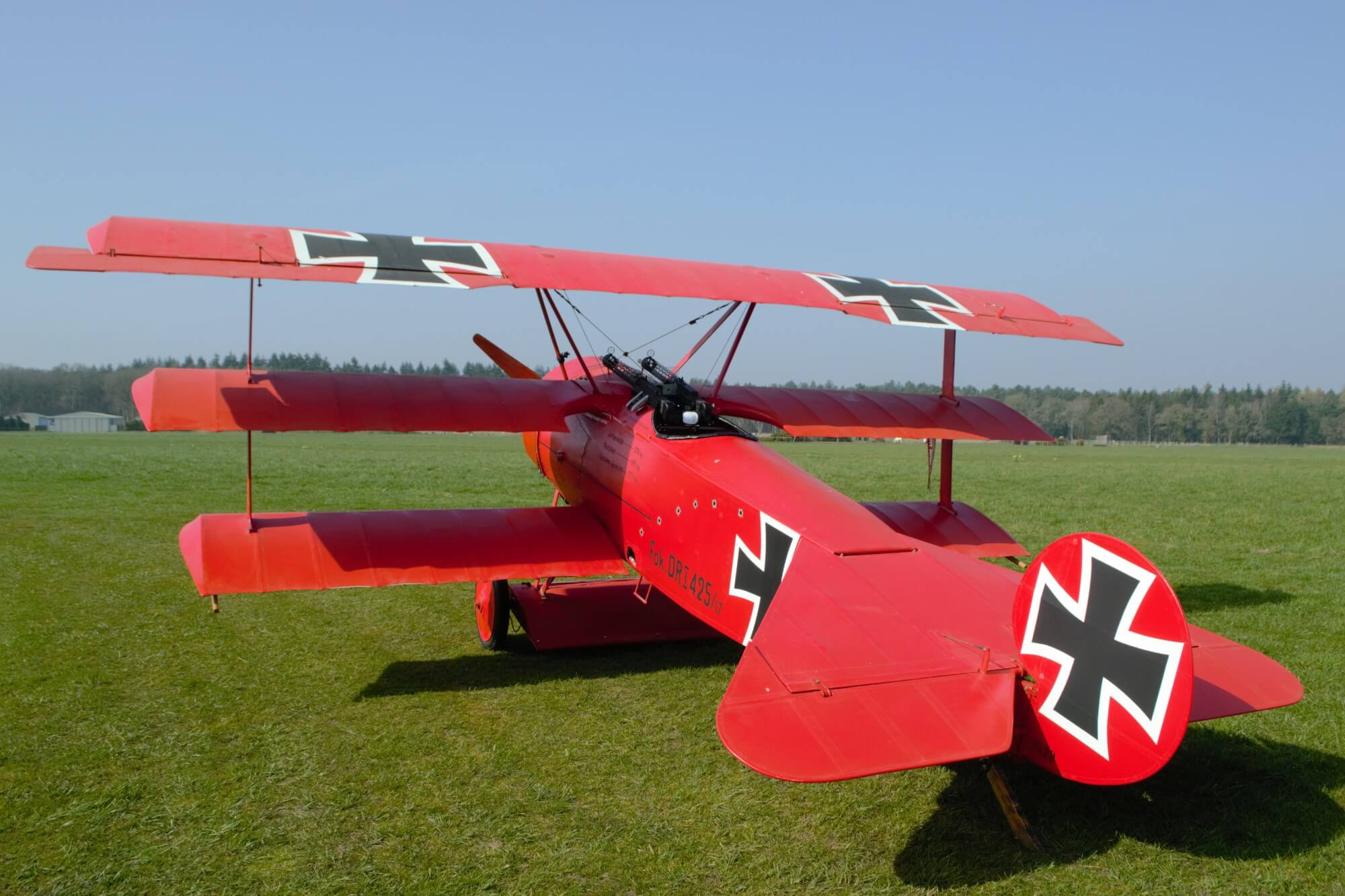
The photograph captures a good replica of the iconic Fokker Dr 1 triplane. The baron made 19 of his confirmed 80 kills while flying a Fokker Dr 1 triplane. Image furnished courtesy of aerotime.aero
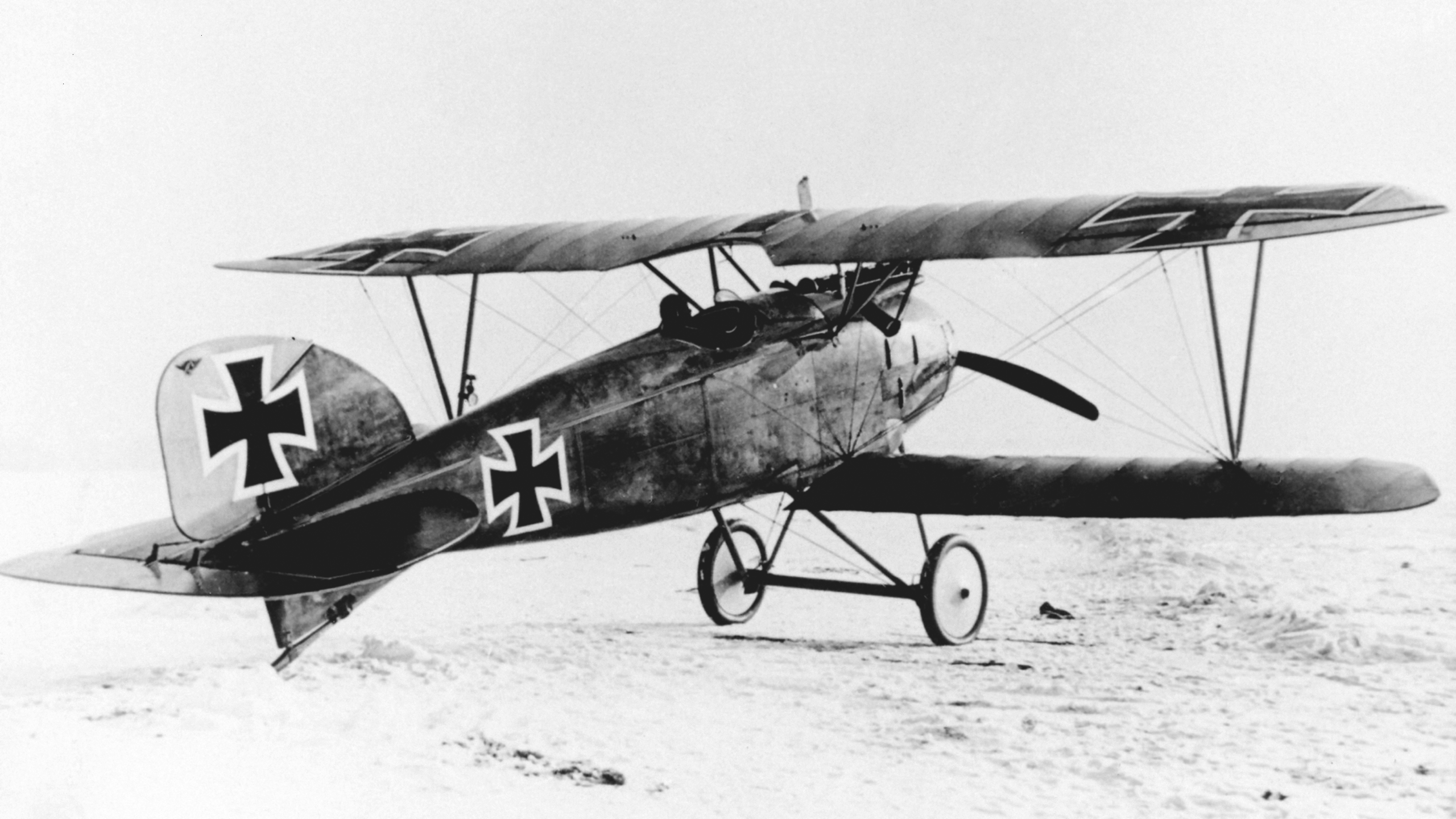
The Baron is most associated with the Fokker Dr 1 triplane, but most of his wartime flying was done in an Albatross DIII biplane fighter like the one pictured above. Image courtesy of plane-encyclopedia.com
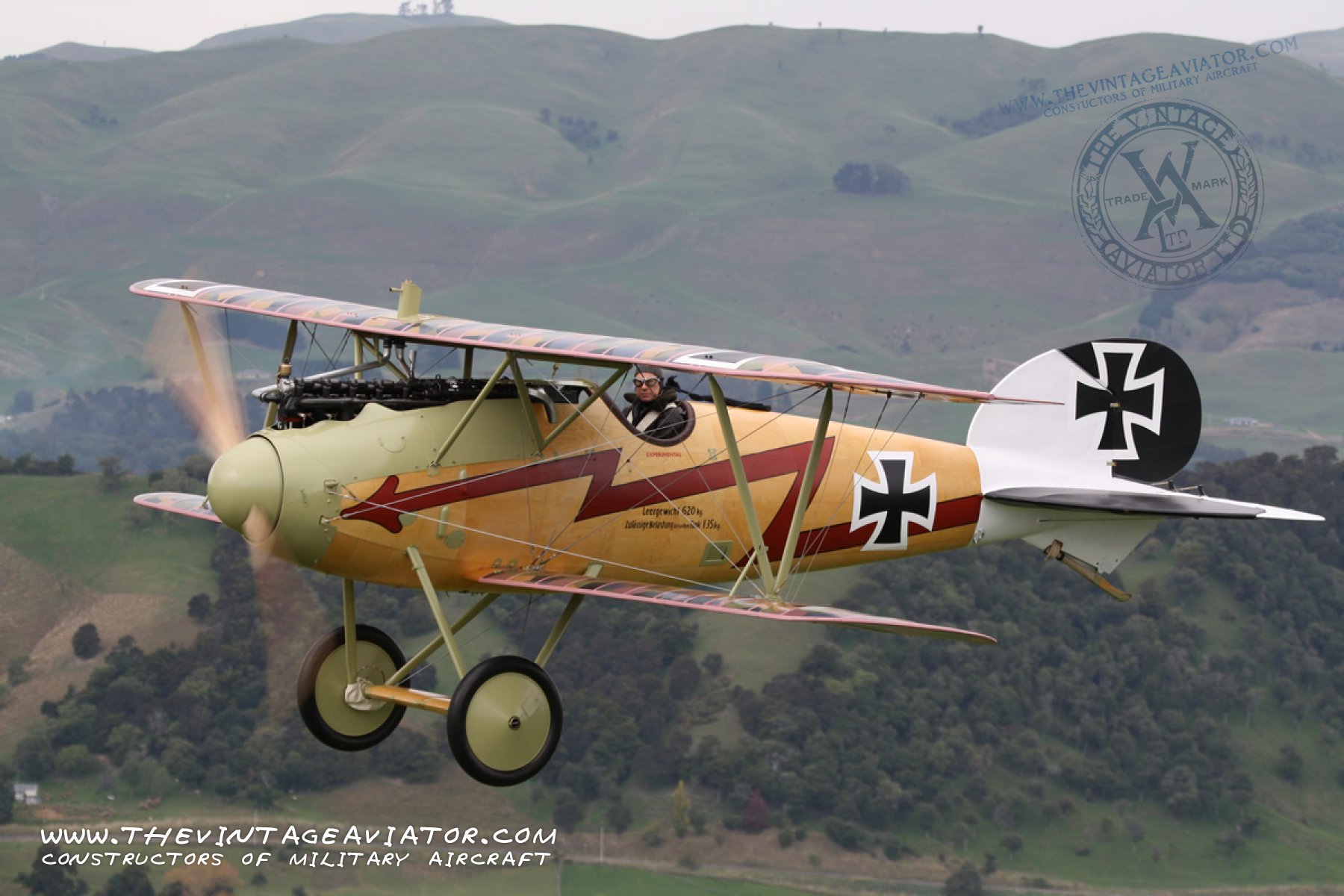
Image of an Albatross DIII replica airplane furnished courtesy of thevintageaviator.co.nz
First, we are not here to rehearse von Richthofen’s biography because this has been done all the way up into the clear blue empyrean by dozens of websites and endless print matter. The fact that you are reading this article strongly suggests you have already perused some biographical information about World War I’s most iconic historical figure.
Second, we shall not go into the post mortem polemics about who REALLY killed Von Richtofen. Again, this issue has been covered many times by countless experts, pundits, and cranks of all stripes. One is free to pass judgements on the Baron’s whodunnit at his own leisure. So, let us examine the life of Manfred von Richthofen without any queries from Hercule Poirot. Besides, as old Shakyamuni, who is commonly called The Buddha, has taught us, when one is shot with an arrow, the highest priority is to tend to the arrow’s wound as opposed to commencing an investigation into who fired the arrow.
RENE FONCK

Lastly, this piece will not mire itself in the tired question of which flier was actually the Great War’s “Ace of Aces.” As is well known, Rene Fonck in his shamefully self-promoting eponymous autobiography laid claim to 56 unconfirmed victories in addition to his 75 verified kills. Fonck’s confirmed kills combined with his self-reported kills swells his total kill-count to a comfortably Baron-besting 152. Or again, George Madon averred that his 41 confirmed kills were more than doubled if one counts the 62 claims that were denied to him.
One can only deplore such naked favoritism amongst non-German researchers because such extraordinary claims bypass any deeds of valor on the German side.* Finally, we should leave the arguments about who was World War I’s Ace of All Aces to the autists lurking in online forums.
THE BATTLE FOR WHO WAS WORLD WAR I’S ACE OF ALL ACES
![]()
Image of the Ace of Base band furnished courtesy of soundcloud.com
Besides a leaving behind a hastily written war-time biography named “Der Rote Kampflieger,” the Baron penned numerous letters to his family and friends before turning in his requisitioned meatsuit. A sampling of quotes from the Baron’s own writings goes far to show the tenor of this man’s mind and these legacy writings provide people living today with plenty of food for reflection into the Baron’s life.
Part 2. FACTS, QUOTES, & COMMENTARY
A. DID THE BARON “COME FROM MONEY”? (2)

Image furnished courtesy of crae_crae-crazy on eBay.com
A recent tabloid-style piece published on a generally respectable website tells us that baby Manfred was born into wealth. While the elder von Richtofen was of the noble class, this scarcely signals opulence. A “Freiherr” (Baron) was the lowest level of nobility in Imperial Germany, and these titles were tied to hereditary service and land ownership. However, old German titles of nobility had nice rings to them back in those days, but holding these titles is was not strictly contingent on having a lot of wealth. Most individuals now conflate being of the “nobility” with being very “rich,” and this conflation says a great deal about the degree to which economic viruses have sickened today’s body politic. The fact that most people can no longer distinguish between being wealthy and being a noble person punctuates our current sorry state of affairs.
The full name of Manfred’s father was: Major Albrecht Philipp Karl Julius Freiherr von Richthofen — that name is a mouthful indeed . The full name of the baron’s mother was: Kunigunde von Schickfuss und Neudorff — this name is also quit a mouthful. The baron had an older sister named Ilse and two younger brothers, one brother was named Lothar and the other was named Bolko. It is germane to mention that the baron’s younger brother Lothar was also a bit of an ace fighter pilot as well with 40 confirmed kills to his name. Unlike Manfred, Lothar managed to survive the Great War, but he died in a civilian airplane crash in 1922 leaving behind an ex-wife (yep, poor old Lothar got tagged by the D-bomb) and two young daughters.

The Image above pictured Lothar von Richthofen and is furnished courtesy of wikipedia.org

The photograph seen above was taken on April 23rd 1917 and features Manfred sitting in the cockpit of the airplane and Lothar seated at the from of this group of flyers. Image furnished courtesy of wikipedia.org
“As a little boy of eleven I entered the Cadet Corps. I was not particularly eager to become a Cadet, but my father wished it. So my wishes were not consulted.” — Manfred von Richthofen
Writing a decade and a half after entering the Cadet Corps, the Baron looks back on his past with a certain ironic amusement and he accepts the fact that his wishes were at best a peripheral matter to the issues at hand. The lesson that von Richthofen took away from being forced to enter the Cadet Corps was not a notion that he was victimized or “traumatized,” but instead, he simply felt that is personal wishes were overridden. Rather than seeing himself as a victim, the Baron simply saw his enrollment in the Cadet Corps as a stepping stone along his path to becoming the type of man that this his birth and class demanded him to become.
A former Google search for the great NFL quarterback named Bart Starr almost invariably leads to a discussion about his “brutal hazing” in college which scarred him for life. Starr’s brutal hazing during his college years was a matter that he never chose to talk about before his death; however, the mainstream Jewish media’s treatment of this subject is plain to see, their message is clear: only tales of victimhood fit within our present culturally mandated narrative. We will return to this point at the end.

A notable quote from the Baron’s biography reads as follows:
“At school I had a tremendous liking for all sorts of risky tricks. One fine day I climbed the famous steeple of Wahlstatt and tied my handkerchief to the top. Ten years later, when I visited Wahlstatt, I saw my handkerchief still tied up high in the air.” — Manfred von Richtofen
The Baron’s handkerchief caper was a schoolboy stunt, for sure, but as the sequel makes clear, apparently this stunt was not repeated by others. When analyzing the Baron’s handkerchief caper, one senses the unshakable confidence that the young von Richthofen gained by performing such “risky tricks.” While Von Richthofen did not live long enough to become anything other than a highly pragmatic fighter pilot, it is interesting that a number of esotericists, among them Evola and Alastair Crowley, pursued and recommended mountaineering as an exercise that was highly conducive to pursuing the occult sciences. Evola, Crowley, and the Von Richthofen certainly disregarded the idea that “You can never be too safe.”
“In my school days, I never was good at learning things. I did just enough work to pass. In my opinion it would have been wrong to do more than was just sufficient, so I worked as little as possible.” — Manfred von Richtofen
It is always awkward to find a paragon who also has feet of clay. When we read about von Richthofen describing how he refused to stir himself to move, this revelation gives us some pause. Concerning von Richthofen’s lackluster scholarship ethic, one could try to put a good face on things and plead that many great people eventually outgrow their laziness. On the other hand, one might take this stance seriously. Spain’s notable philosopher named Ortega y Gasset got considerable mileage out of the etymology of the Spanish word “trabajo” (work) which traces its entomology back to the Latin term “trepalitum” (torture.) With scorn worthy of an old Roman, Manfred von Richthofen believed that maintaining presence and poise across every one of life’s myriad situations was a much more valuable trait of character than simply having the compulsion to expend effort on relatively trivial matters.
In this vein, it is worth noting that the Baron was not a particularly skilled flyer, and he was not a storied shot. Rather, following his mentor Oswald Boelcke’s lead, the Baron sought to close with the enemy, then get his airplane as near as possible to his opponent — even to the degree of achieving point-blank range — then he would fire at his opponent with everything he had. In his own words, “Find the foe. Shoot him down. Everything else is nonsense.” (3) Again, we find von Richthofen doing what he always did best — doing just enough to get the job done.
Excessive casualties early in the First World War strongly indicate that cavalry was actually an outmoded arm of the German military machine at that time. As the war progressed, Rittmeister von Richtofen’s Uhlan (heavy cavalry) unit soon found themselves delivering dispatches and laying phone lines instead of heroically, but perhaps foolishly, charging into enemy lines on horseback. The thing about the Baron’s previous quoted request is the unabashed tone he uses when voicing his sanguinary purpose.
UHLANS + BARBED WIRE=…
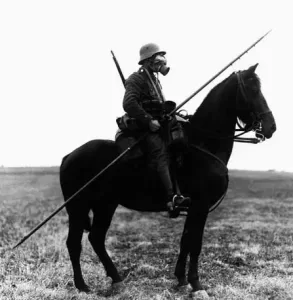
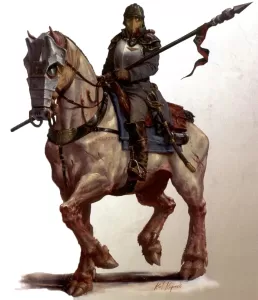

“Your Excellency…I have not gone to war to collect eggs and cheese, but for another purpose altogether.” (Von Richtofen’s request for a transfer to the fledgling “Luftstreitskraefte” — Manfred von Richtofen
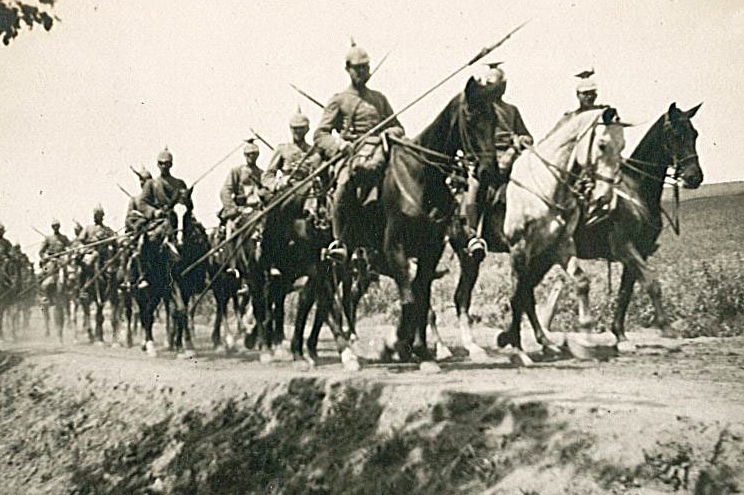
Image of a World War I German cavalry unit furnished courtesy of the Leo Baeck Institute’s website.
The reluctant hero is a tired trope that has been floating around in the West for generations now, and the reluctant here is always a man who is a shirker who only finds his hero’s groove when his back is against a wall and he suddenly discovers his inner Achilles. In this trope of the reluctant here, we see the inner split that has bedeviled Western man since the Christian Nazarene creed was first ingrafted. A great deal of the emotive force behind both World Wars was to stoke the martial spirit in races where this impulse still held strong sway, especially in Germany and Japan. By contrast, the present cultural wars raging across whatever is left of the west demonstrates that that an epicene culture is now promoted that regards any displays of masculinity from White men as utter gaucherie.
“Fight on and fly on to the last drop of blood and the last drop of fuel, to the last beat of the heart. Success comes only in perseverance, ceaseless restless perseverance.” — The Baron von Richtofen
In July 1917, the Baron was wounded when a machine gun bullet grazed his skull and left him with one temporarily blinded eye and a fracture to his skull. In this particular instance, the Baron recovered his plane from the ensuing spin that following his meeting with that bullet; he very nearly crashed after this incident and the symptoms from this wound plagued him throughout the remaining ten months of his life.

Preaching perseverance might seem trite; however in recent times such crazy habits being persistent, planning ahead, showing up on time, and displaying simple courtesy have all come under public attack and labeled symptomatic of “white supremacy.” At the last Olympics, “Greatest of All Time” gymnast Simone Biles was lavished with a lioness’es share of praise for her “courage” when she quitting during mid-competition due to “personal issues.” Von Richtofen’s words that recount his personal crisis in the air indicate that there is no substitute for “obvious” virtues when one finds himself on his own and facing death.
VON RICHTOFEN WOUNDED
“I honored the fallen enemy by placing a beautiful stone on his grave.” — Manfred Von Richtofen.
The to which the quote above refers is the British ace named Lanoe Hawker who was slain by the Baron in November 1916. Acts of chivalry on both sides were, of course, not uncommon during the Great War. Richthofen himself would be buried with all honors by the British in 1918. What is worth commenting on here is the Baron’s (and the Britishers’) timing in this matter.
A recent Sabaton song “No Bullets Fly,” for deplorable counter-example, extols the German pilot named Franz Stigler. This Sabaton song commemorates the time when Stigler spots a crippled American B-17 bomber whose pilot refused Stigler’s gestures to land. In this incident, the German pilot took pity on the wounded American plane, then guided the plane on a course that took it back to safely in England. In effect, Stigler’s actions preserve the life and equipment of an enemy crew who will soon return to carpet-bombing Stigler’s fellow German civilians. As the Furhrer pointed out in the early going of World War II, objectivity about oneself and one’s enemy is a polite term for suicide. Von Richtofen’s gesture to Hawker suggests that the proper time for chivalry is AFTER the foe has been neutralized.
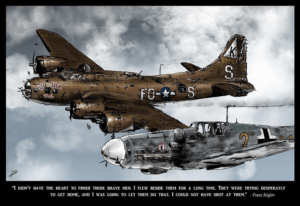
SABATON’ HYMN TO RACE BETRAYAL, “NO BULLETS FLY”
“The English had hit upon a splendid joke. The intended to catch me or to bring me down.” — Manfred von Richthofen
Today, a great many of us have had this experience or something like it: the (diversity hire) lady professor is lecturing the Western Civilization survey course’s class on the Battle of Thermopylae. “…When told that the Persians were so many their arrows would darken the sun, King Leonidas said, ‘Good. Then we shall fight in the shade.’ (disapproving pause) As you can see, Leonidas was on his own private macho trip, squandering the lives of those Greek boys.” (guffaws of in-the-know laughter)

Image courtesy of midwestfilmjournal.com
The fact remains though, people have a long history of making jokes out of immediate and present dangers. This practice is grim, yes, and it is daunting on some levels, yes again; however, it is making a joke nevertheless. In war, when enemy bullet that misses you, this constitutes a joyful occasion. Wildly swinging crab pots on the decks of Bearing Sea fishing vessels that finds ways to miss you also constitute joyful happenings. When Rottweiler dogs back down, and Rasheeds are stared down, such incidents are additional events of celebration. Some individuals have a greater natural gift for appreciating lucky events than others, however, one never knows his own capacity to appreciate joyous events until he has ventured out and experienced these occurrences for himself.

GIF furnished courtesy of tenor.com
It is a cultural crime to label every danger that a person successfully navigates as “trauma.” Psychological studies suggest that, far from being ubiquitous, only about 10% of any given population is naturally susceptible to developing PTSD. One could argue that the predisposition towards developing PTSD follows the same percentages as the occurrences of gender dysphoria and mild levels of autism. In short, susceptibility to PTSD can be classified as a proclivity of the psychologically vulnerable. The Baron’s attitude towards physical danger suggests that he followed an older and sterner credo that is and worth exploring. (4)
CONCLUSION
I have hinted that one aim of the “Allied” forces over the course of two “World Wars” was to eradicate the idea of warrior spirit. One could argue that the “Allied” forces intended to “close and seal the Sphere of Honor” as Argentina’s old Tyrodhal Knights Order put it. In this line of thought, it is worth recalling the origins of the Prussian state. The original Prussian state began as a kingdom was initially taken and held by the Teutonic Order of Knights. In 1526, under the influence of Martin Luther, the Grand Master Albrecht dissolved the Teutonic Order of Knights and the erstwhile ecclesiastical hierarchy of the region became secular nobles.
GRAND MASTER cum DUKE ALBRECHT
These “Nobles” that follow the rulership of Teutonic Knights were really only “Secular” in name because the old warrior-monk spirit lived on in these men. Down the centuries, and progressing into the 20th century, the Prussian nobility and commonality alike were characterized by the strong sense of duty that had been the backbone of the old Teutonic Order of Knights. Well into the 20th century, the native people of Prussia maintained a strong sense of duty that was rooted in their land and their shared sense of ethno-history. The people of Prussia maintained a sense of the transcendent importance of “Blut und Boden,” up until the time of the Third Reich.

Illustration of the old Teutonic Order of Knights furnished courtesy of quora.com
Von Richtofen was heir to his ancestral Prussian history of honor and duty that stretches back to the old Teutonic Order of Knights. Earlier, we dismissed the tedious question of whether the Kampflieger was indeed World War I’s “Ace of Aces.” We also spoke approvingly of the Baron’s willingness to falling in line with his father’s wishes by bravely sighing, “My wishes were not consulted.”
There is a scene from the film “The Blue Max” that perfectly captures the Baron’s quintessentially “Prussian” attitude. In this scene, the (curiously American-acting) Unterleutnant Stachel who was played by George Peppard is newly arrived, and he is bemoaning the fact that the first enemy plane he shot down has gone unconfirmed. In response to his distraught mindset that is spurred by having his kill go unconfirmed, Stachel queries an amused and aristocratic officer named Willi von Klugermann who was played by Jeremy Kemp.
Stachel asks, “How many kills have you got?”
When queried, Klugermann responds, “Eighteen.”
In turn, Stachel asks, “Any unconfirmed?”
Klugermann responds in kind, “Three.”
In response, Stachel retorts, “So, you have twenty-one!”
“No,” purrs Klugermann with a mocking lilt to his voice. “I have eighteen.”
Encapsulated in the, “I have eighteen” dialog is an entire Weltanschaaung that is dedicated to order, personality, and the proper topography of a man’s spirit. Reflection on Von Richthofen can open a doorway into this almost forgotten world.
NOTES:
- True, prevailing winds on the Western Front DID lessen the odds of crippled German planes falling inside Allied lines. To what degree this affected British and French fighter pilots’ scores remains the perennial debate.
- https://militaryhistorynow.com/2014/01/15/get-your-baron-on-14-amazing-facts-about-germanys-most-famous-flying-ace/
- Yes, Von Richtofen was eventually killed. Whether his skills were lacking were hard to say. It is worth recalling that “Bubi” Hartmann followed Von Richtofen’s advice in the next war, scoring 352 victories and surviving to a ripe old age.
- See Peter Caroll’s, “Liber Null & Psychonaut.” This (rather too allusive) introduction to Chaos Magick offers a good treatment of the role of laughter in coping with untoward events, including physical or psychological danger.
PHOTO CREDITS
RICHTOFEN IN REPOSE www.redbubble.com
MANDATORY AIR COMBAT SCENE
A PIZZA TO END ALL PIZZAS?
https://truthinadvertising.org/class-action/red-baron-brick-oven-pizzas-2/
RENE FONCK
http://87dit.canalblog.com/archives/2016/08/24/34224568.html
THE BATTLE FOR WHO WAS THE ACE OF ACES
RELUCTANT CADET https://www.donhollway.com/redbaron/
UHLANS +BARBED WIRE=DISASTER
https://www.fruugo.co.uk/the-german-cavalry-the-uhlans-come-up-against-barbed-wire
VON RICHTOFEN WOUNDED
https://www.history.com/news/ace-of-aces-how-the-red-baron-became-wwis-most-legendary-fighter-pilot
SABATON’S HYMN https://www.zhihu.com/question/266826833






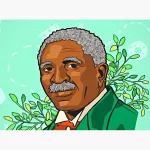

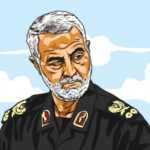



2 Responses
Thank you for stating the Buddha, has taught us, when one is shot with an arrow, the highest priority is to tend to the arrow’s wound as opposed to commencing an investigation into who fired the arrow.
Great article, and writing style!
But as a former Marine and son of a WWII and Korea Marine, months of constant terror can wear down anyone and lead to PTSD.
My father was an outstanding Marine NCO (fighting at Iwo Jima) and a captain in Korea, but he had to see a Navy shrink for six months to curd his nightmares and insomnia. It was attacks on his trench line day and night for months and constant hand-to-hand combat.
Plus the North Koreans did horrific things to captured, live Americans.
He was in a coma for three days from a Chinese mortar round, waking up in a Tokyo hospital, whereupon he was sent home. And my father was one of the toughest and most successful men I ever met.